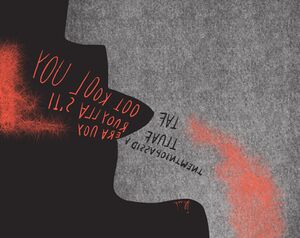Special Issue 18 Work: Difference between revisions
(→Weekly) |
(→Weekly) |
||
| Line 12: | Line 12: | ||
personal introductions: bio by using interconnections; also later on with less/no "my", "I" [by Femke]<br> | personal introductions: bio by using interconnections; also later on with less/no "my", "I" [by Femke]<br> | ||
''My parents wanted to have a boy after already having two daughters. They were so sure it will be a boy and decided to name it Alexander. | ''My parents wanted to have a boy after already having two daughters. They were so sure it will be a boy and decided to name it Alexander. | ||
''I self-trained and created by practice in visual translation - putting complex concepts and ideas into images. | ''I self-trained and created by practice in visual translation - putting complex concepts and ideas into images. My creations are part of who I am and I am part of my creations. | ||
''I am where I am because I was always struggling with the social constructs I was expected to follow - never fitting into 9-5 jobs or following a traditional educational path.'' | ''I am where I am because I was always struggling with the social constructs I was expected to follow - never fitting into 9-5 jobs or following a traditional educational path.'' | ||
''Since childhood I was discouraged to pursue a path in art, that is why it took me so long to get here :D But I got quite some various skills on the way connected to marketing, entrepreneurship, music, djing, dancing, drawing, designing...'' | ''Since childhood I was discouraged to pursue a path in art, that is why it took me so long to get here :D But I got quite some various skills on the way connected to marketing, entrepreneurship, music, djing, dancing, drawing, designing...'' | ||
Revision as of 23:57, 20 April 2022
Concept
[everything is interconnected] [implication] [responsibility] [relationality] [becoming] [interdependency] [resonance] [interference] [entanglement] [techno-ecology]
Weekly
- week 00 [prep & setup + covid as an extra]
introduction to the special issue topic & process
personal introductions: bio by using interconnections; also later on with less/no "my", "I" [by Femke]
My parents wanted to have a boy after already having two daughters. They were so sure it will be a boy and decided to name it Alexander. I self-trained and created by practice in visual translation - putting complex concepts and ideas into images. My creations are part of who I am and I am part of my creations. I am where I am because I was always struggling with the social constructs I was expected to follow - never fitting into 9-5 jobs or following a traditional educational path. Since childhood I was discouraged to pursue a path in art, that is why it took me so long to get here :D But I got quite some various skills on the way connected to marketing, entrepreneurship, music, djing, dancing, drawing, designing... After I participated in a training in France, I became part of an association there that gave me the opportunity to completely change my path and be able to navigate it. And with them, to create space for others to gather, experiment with topics and tools they are passionate about.
My need of establishing my practice and focusing brought me here.
terminology & technical setup of the studio that I missed
self-isolation & covid... #canceleverything
[pads] personal, special issue, prototypology
- week 01 [listening to our first contributions, editing on Audacity, notation]
first contributions, listening
prototyping: editing sound, effects on Audacity
writing, reading: notations - theory & experiments
work in group for next week: w/ Gersande and Carmen
[pads] personal, special issue & prototyping, reading&writing, notation experiments, notations w/ carmen & grgr
Contributions
week 01 - field recording, glitch editing w/ audacity [work w/ Emma]
[about] During the creation time for our first contribution, I was self-isolating at home because of covid; and Emma was visiting her family in Belgium. Emma suggested the idea and she later mixed the recordings so we can hear the two recordings merged. It is an interesting contrast between her being at a different place every time, whereas I was being in the same space where there was not much happening.
[field recording] We did several field recordings of the time and place we were at some given moments. The field recording format was [1] introduction of time and place; and [2] recording of the sounds in the space. We also took one photo of that moment.
[photo glitching with audacity] I became interested how Audacity can be used to create glitched images. Thus, I experimented with that on the documentation photos we took using this tutorial as a base (and a few more).
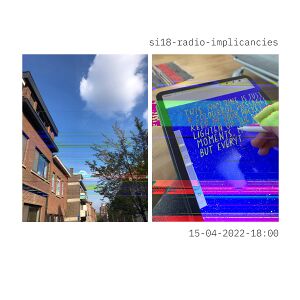
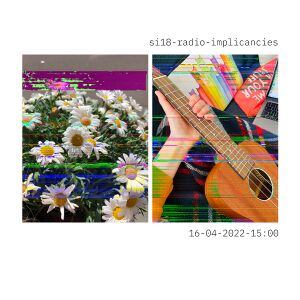
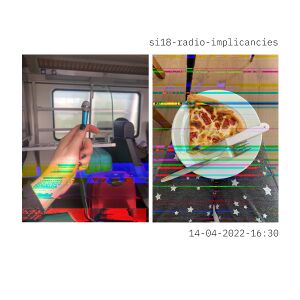
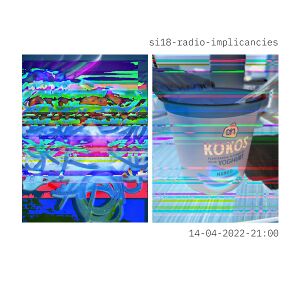
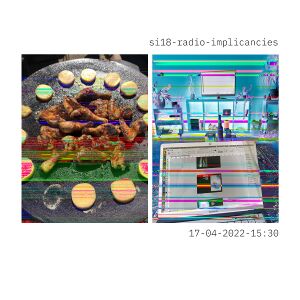
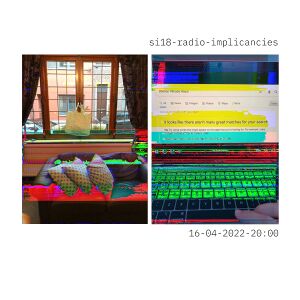
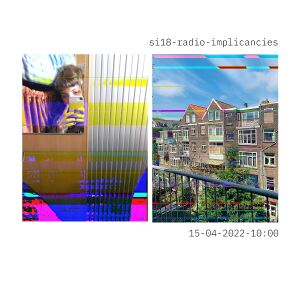
week 02 - tba [work w/ Gersande & Carmen]
[concept] Uneven Patterns
[documentation] here
[about] tba
Experiments
00. Notations w/ Carmen & Erika [Steve's class]
[about] During the activity we created notations which should be performed and recorded. Our trio, The Blind-Smashed-Orchestra had several ideas on which we made 5 different try-outs. Finally, we selected two of them: "the blind-smashed orchestra" and the "loop-stretch-cut". 20/04/2022
rec 1 blind-smashed-orchestra
instructions:
Imagine you are the conductor of an orchestra. Choose some musicians and form a circle with them.
start playing your masterpiece invoking the names of the instruments that will be given to each musician (f.e. you say drums looking at someone and this person will be in charge of the drums) The orchestra is a very special one. An orchestra of flat bodies laying on the ground. Blindfolded. Facing down. So as soon as you name the instrument the person in charge of it will crash on the ground and start improvise imitating that instrument. (you can choose between drums, winds, strings, vocals)
In the end join your musicians on the ground and direct your orchestra!
▶ recording
rec 2 loop-stretch-cut
instructions:
In a group of 3 people:
person 1 chooses a word and starts repeating it (as a loop)
person 2 waits a bit and starts stretching the word (as if it is stretched on Audacity)
person 3 waits a bit and starts to perform cuts of the word (as if it's cut on Audacity)
keep the performance for a while :-)
a special tribute to Manetta's homework assignment
▶ recording
rec Covers
We also did three covers of notations by Miriam and Emma:
Imagine you're the owner of a café and your coffee machine just broke down. You try imitating the sounds of a coffee machine so the customers won't notice that the coffee machine broke. ▶ recording
Hum the sound of a commercial jingle you know but with your mouth open. ▶ recording
Stare at the sun without sunglasses. Describe the feeling in a calm and juicy way.
▶ recording
01. How Does Anxiety Sound Like / individual work [prototyping]
[about] Our weekly assignment for the next prototyping class was to make a recording and use one (or more) of the effects on Audacity (repeat/stretch/cut/reverse) following some additional constrain. My first try was actually a longer piece coming from a personal need to explore some sounds and progression. Actually, I used almost all of the effects (except for reverse) for this piece:
▶ listen to how does anxiety sound like [caution: it's a bit dark]
▶ notation
[process] The core material is my voice saying "wow". Then, I changed the pitch to 2 levels down; 2 levels up and stretched them both with different rate. I repeated some of them and placed on different tracks, so they can overlap. Lower pitch sounds visualise the first signs of distress and the constant vibration/noise of the body after the climax. Higher pitches depict the moments of panic/histeria/fear or feeling of I cannot stand this anymore - the climax. Recorded and mixed on Audacity; computer microphone used.
02. Reversed Words / individual work [prototyping]
[about] Have you ever said something to a person you love that you wish you had never said? You cannot take your words back, can you? After doing the first experiment with the Audacity effects, I realised I didn't do anything with the "reverse" effect. I started thinking of what could be interesting to be reversed? Then, I quickly came up with the idea of reversing (as taking back) something you said. How would it sound to "delete" or "take back" what you said and immediately regretted. Here are some quick experiments:
▶ listen to reversed words
▶ notation
[process] First, I recorded my voice saying the three phrases. Then, I made the pitch one level down. Copied them and reversed. There is a tiny overlap between the "proper" phrase and the "reversed" one. There is another track with a slight sound on the background to fill in the silent moments between the three phrases. Recorded and edited on Audacity.
Terminology
Radio Implicancies is about practicing interdependencies. About how to stay with the complex entanglements between the personal, the economical, the political and the computational. About thinking, using and making technology with mutual relations in mind.
- agential realism
According to Barad's theory of agential realism, the universe comprises phenomena, which are "the ontological inseparability of intra-acting agencies". Intra-action, a neologism introduced by Barad, signals an important challenge to individualist metaphysics.
Key Figures
[Karen Barad] is an American feminist theorist, known particularly for their theory of agential realism. Their research topics include feminist theory, physics, twentieth-century continental philosophy, epistemology, ontology, philosophy of physics, cultural studies of science, and feminist science studies.
[Denise Ferreira Da Silva and Arjuna Neuman] our issue's title is borrowed by their film 4 Waters: Deep Implicancy is a poetical exploration of rivers, histories, volcanoes and schools of thought that flow together.[2] The “Deep implicancies” in the title of their film signals the entangled responsibilities for maintaining colonial hierarchies between what and who is considered to be of value or not. Denise Ferreira Da Silva is an academic and practicing artist, Dr. Denise Ferreira da Silva’s work addresses the ethico-political challenges of the global present. Arjuna Neuman is an artist and filmmaker based in Berlin. He works with the essay form with a multiperspectival and mobile approach where ‘essay’ is an inherently future-oriented and experimental mode, becoming the guiding principle for research and production, which shifts between the bodily, haptic and affective through to the geopolitical, planetary and cosmological.
Readings
- Barad, Karen (2007). Meeting the Universe Halfway: Quantum Physics and the Entanglement of Matter and Meaning


